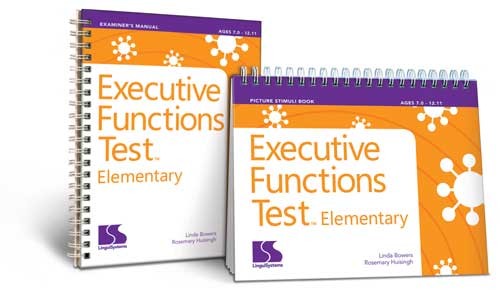*DISCONTINUED (*NEW EDITION in Alternatives below)
Executive functions skills allow humans to internally regulate their behavior to get to a desired outcome. The Executive Functions Test Elementary is a diagnostic test of language skills that affect executive functions, such as working memory, problem solving, inferring, predicting outcomes, and shifting tasks. It is designed to assess a subject's ability to use his language skills in various executive functions.
Executive function capacities begin to develop shortly after birth and continue throughout adolescences and early adulthood. The specific tasks of the Executive Functions Test Elementary are constructed to yield information about these areas of executive function and language to assist the professional in identifying areas of strength and weaknesses in a child's language and cognitive communication skills.
Subtests
•Subtest A: Attention and Immediate Memory — Auditory
This subtest presents short passages with three follow-up questions to determine a student's ability to pay attention to details and remember what she hears.
•Subtest B: Attention and Immediate Memory — Auditory and Visual
This subtest presents illustrations and short vignettes. Students answer questions about what they've heard and seen in the pictures. There are three questions for each vignette, two require attention to detail and one presents a problem to be solved.
•Subtest C: Working Memory and Flexible Thinking
These two executive functions are tested by asking the student to listen to a short passage and answer two "thinking" questions.
•Subtest D: Shifting
Being able to shift one's thinking quickly and accurately is an important executive function as it allows one to be adaptive to life's changing demands. The items in this subtest have two parts; first, the examiner names four items in a category and identifies the category. The student is then asked to name a member of a similar but different category.
Test Procedures
•All items in each subtest are administered in their entirety.
•Begin with the first item in Subtest A: Attention and Immediate Memory — Auditory. Read each passage and ask the test item questions in the order listed on the test form. All items are administered orally.
Scoring/Types of Scores
Specific scoring guidelines and criteria for determining correct and incorrect responses for each test item are provided in the Scoring Standards chapter of the Examiner's Manual. Correct and incorrect responses are also referenced on the test form. Scoring for each subtest is 1 or 0 for correct/incorrect responses.
•Raw scores convert to:
- Age Equivalents
- Percentile Ranks
- Standard Scores
Discussion of Performance
This section found in the Examiner's Manual, was developed to guide the examiner to make appropriate and educationally-relevant recommendations for remediation based on a clear understanding of each subtest.
The skills students need to be successful on each subtest are delineated and applied to language and cognitive performance.
Error patterns are identified and the implications for why the student responded incorrectly are given.
General remediation strategies you can incorporate immediately into your therapy program or ask teachers and parents to do are also included.
Standardization and Statistics
Several attempts to develop appropriate subtests were discarded as the items did not show strong age progression. Details of these attempts can be found in the Examiner's Manual.
The final version of the Executive Functions Test Elementary was designed to be administered to children ages seven years of age and older. Test norms were established on children from 7 years, 0 months through 12 years, 11 months.
Two studies were conducted on the final version: the item pool and standardization studies.
The item pool study consisted of 440 subjects. The test was standardized on 723 subjects that represented the latest National Census for race, gender, age, and educational placement. In addition, 476 subjects with language disorders, learning disabilities, and autism spectrum disorders were used in the validity studies.
•Reliability—established by the use of the following for all subtests and the total test at all age levels:
- SEM
- Inter-Rater Reliability
- Test-Retest
- Reliability Based on Item Homogeneity (KR20)
The test-retest coefficient is .94 for the total test, the SEM is 4.68 for the total test and the KR20 coefficient is .96. Given the uniqueness of the test, the clinical population, and scoring criteria, the reliability is considered highly satisfactory.
•Validity—established by the use of construct and contrasted group validity.
- Contrast Groups (t-values)
- Point Biserial Correlations
- Subtest Intercorrelations
- Correlations Between Subtests and Total Test
Results revealed highly satisfactory levels of item consistency (98%). Internal consistency estimates are clearly satisfactory. The test differentiates students with language disorders, autism spectrum disorders, and learning disabilities from students with typical language development.
•Race/Socioeconomic Group Difference Analyses—conducted at the item and subtest levels. The analysis of performance differences among race/socioeconomic groups was conducted at the subtest level.
- Z-tests Chi Square analysis at the subtest level
- Analysis of Variance (ANOVA) F-tests
In 67 of the 72 statistical tests for race and socioeconomic combinations, there were no significant racial or socioeconomic differences. This low occurance for race or socioeconomical differences on test performance indicate that neither is a strong impact on the Executive Functions Test Elementary at the item level.
- Copyright 2014

 Proud to be Canadian
Proud to be Canadian

